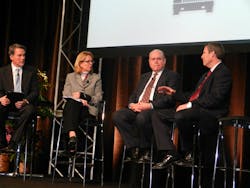FMCSA hopes to launch split rest study this year, Ferro says
The Federal Motor Carrier Safety Administration is confirming its plans to study whether expanding use of split rest in sleeper berths can improve both safety and productivity, FMCSA Administrator Anne Ferro said March 26. In response to a split rest pilot test proposed by the American Trucking Assns. and the Minnesota Trucking Assn., the agency indicated in December that it had already planned to conduct such a study in conjunction with the National Assn. of Small Trucking Companies, the Owner-Operator Independent Drivers Assn. and others.
Speaking during a panel discussion on federal regulation at a Fleet Forum held in conjunction with the Mid-America Trucking Show in Louisville, Ferro said that it is working on getting the necessary approvals within the Obama administration and that it hopes to award a contract for a split-rest study by the end of the year.
“Nighttime rest is best, and daytime rest is least recuperative,” Ferro said, noting the recent change in the hours-of-service rules to require that the voluntary 34-hour restart include at least two consecutive nighttime periods. But FMCSA is committed to continuing its review of its rules to promote safety while preserving flexibility, she said. “Split sleep could be a better option for drivers operating overnights than what we have today.”
Some of the challenges are more systemic and fundamental, Ferro said. “We believe there’s a correlation between payment method and safety outcomes.” It’s a function of “paying by piece work,” which incentivizes pushing limits, and is exacerbated by excessive detention time, Ferro said. FMCSA expects to have preliminary data by the end of 2015 on its study of driver compensation and its correlation with safety.
Ferro believes that carriers missed an opportunity to address compensation with shippers due to the new restart. “We did identify and predict an impact to the industry,” Ferro said, adding, however, that many carriers use the 34-hour restart for flexibility even though they really don’t need to.
“Carriers we work with are reporting a 3% to 5% productivity impact” from the hours-of-service change, said Tom Sanderson, chief executive officer of Transplace, during the panel discussion. Werner Enterprises is reporting a 6% hit in the team environment, he said. Also, shippers are finding the 1 a.m. to 5 a.m. slots a bit problematic when one of those slots is a Sunday night,” Sanderson said.
Another aspect of the rule change is that the 1 a.m. to 5 a.m. period tends to shift traffic into more congested periods, said Bob Henry, an attorney with Scopelitis, Garvin, Light, Hanson & Feary. “One-size-fits-all doesn’t take into account the different circumstances they face.” Ferro responded that she believes the concerns about displacing traffic into busier periods is overblown, but she repeated FMCSA’s pledge to continue reviewing and tweaking if necessary.
Compliance, Safety, Accountability
Ferro also addressed criticisms lodged recently by several governmental entities, including the General Accounting Office, the Dept. of Transportation Office of Inspector General and the National Transportation Safety Board. She characterized the arguments as contradicting one another to a degree and contended that this was a positive, not negative, indication for the agency’s Compliance, Safety, Accountability program. “We have a little bit of Goldilocks scenario where we think we have it about right.”
Still, FMCSA will continue to tweak CSA and related initiatives, Ferro said. FMCSA expects by June to revamp the public website display of carriers’ Safety Measurement System data as it proposed in November. And it plans soon to finalize a proposed change in the DataQs system to remove violations that ultimately are invalidated by court action.
Sanderson acknowledged that with 500,000 trucking operations, FMCSA needs a mechanism to focus its enforcement resources, but he isn’t convinced CSA as it is set up today accomplishes that. “I am concerned that CSA is about meeting requirements rather than driving down accidents per million miles,” he says. “The way it has been used, CSA has gone from being a warning signal to a guilty verdict.” Many very safe carriers are being denied freight because the shipper is concerned about vicarious liability, Sanderson said.
Ferro acknowledged that shippers “are very innovative about what they put into contracts,” but that will not prevent FMCSA from getting the word out about carriers’ CSA performance, she said. “It is very important for FMCSA that we take this analysis and incorporate it to ensure that at the end of the day carriers need to be held accountable for what they are doing.”
Henry emphasized that CSA’s validity is highly dependent on the performance of individual states. DataQs is a good example because some states simply refuse to respond to requests, he said.
Improving the DataQs process is one of three recommendations Sanderson offered for improving CSA’s fairness. The others were a greater focus on uploading inspections that are clean as well as those with violations and ensuring consistent enforcement among all states.

